|
 Dwight Peck's personal website Dwight Peck's personal website
Genoa, Italy, in 2012
A restorative February interlude (2)
We've shaken off the brutal European Cold Wave of early February 2012 and decided to recuperate on the south side of the Alps.
You may not find this terribly rewarding unless you're included here, so this is a good time for casual and random browsers to turn back before they get too caught up in the sweep and majesty of the proceedings and can't let go.
   

Bright and early, we've stopped to pay our devoirs to Mr C. Columbus in front of the Genoa train station and we're off to Savona for the day.
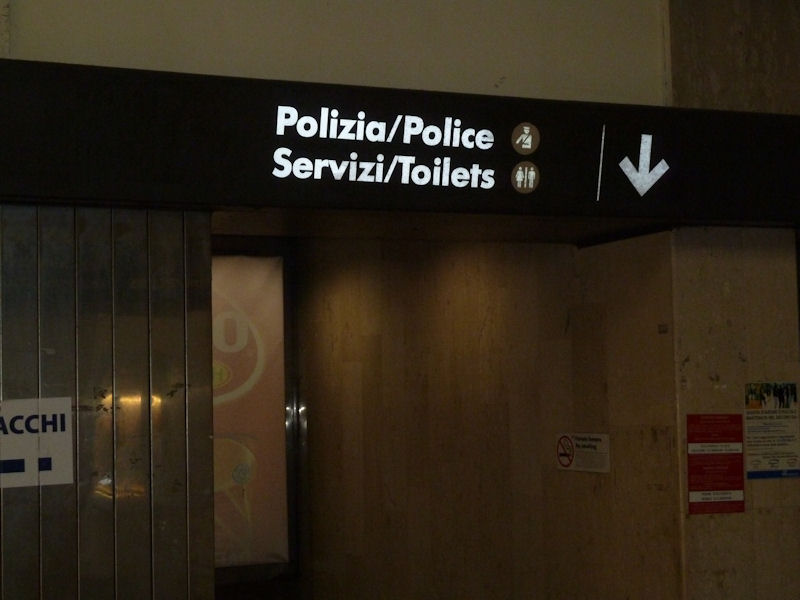
We're offered a choice.

Downtown Savona, some 40 km west of Genoa along the Ligurian coast. Savona has been pretty luckless over time: punished by the Romans for having supported the Carthaginians, liberated from the Byzantines by being utterly destroyed by the Lombards in 641, a plaything of the Saracen marauders until it finally became a free city under the Holy Roman Empire, then levelled in 1528 by the Genoese, who filled in the port to prevent future trade competition. Thereafter it was largely a vassal of the Republic of Genoa until Napoleon came along in 1797 to sort them all out.

This tower is the 14th century Torre Leon Pancaldo, also called the Torre della Quarda, also just called the Torretta, once part of the city walls at the eastern edge of town. It's straight down at the end of the arcaded shopping street, the Via Paleocapa, at the port and marina.
(Leon Pancaldo was a Columbus manqué who circumnavigated the globe with Magellan, spent a long time in the Moluccas as a prisoner of the Portuguese, and died in 1538 at the hands of indigenous people on the River Plate. This is his enduring monument.)

Pasta Fazool. Kristin's extra suitcase is still only half full of dried ready-fix pasta e fagioli.

Bingo!

The Via Paleocapa on a quiet day

The Torretta and Via Gramsci along the port area

Kristin crossing the handsome drawbridge separating the "Vecchio Darsena" or Old Docks of the modern marina from the larger port for the ferries and what not. The sign says that if the bell goes off, you've got two minutes to get off the bridge before it goes up, and it will stay up for five minutes as the rich guy's yacht glides underneath it.
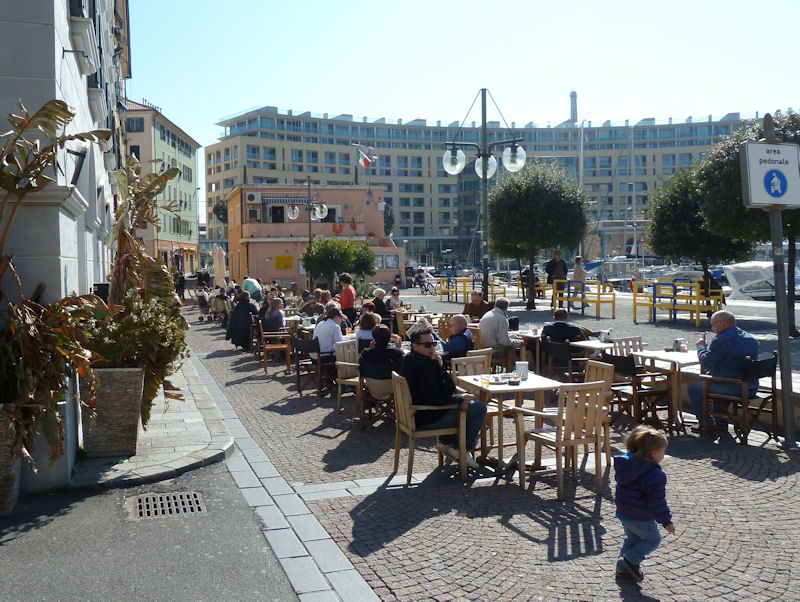
The cafés along the marina on the peninsula of the port facilities, ferry docks, and warehouse yards.

Past the sailing boats, the 12th century Torre del Brandale next to the Palazzo degli Anziani

The tower's very large bell is called the Campanassa, evidently "the commune", where the city's civic freedom was signed in 1191. The smaller towers are the Corsi and the Riario.

Savona boasts many interesting things to see, most of which we didn't. (Like -- get this -- in the countryside, the house of Domenico Columbus, father of You Know Who, where the Founder of the New World spent his youth and retired to write his memoirs (probably somewhat sanitized).) But the pièce de résistance is the Fortezza del Priamar.
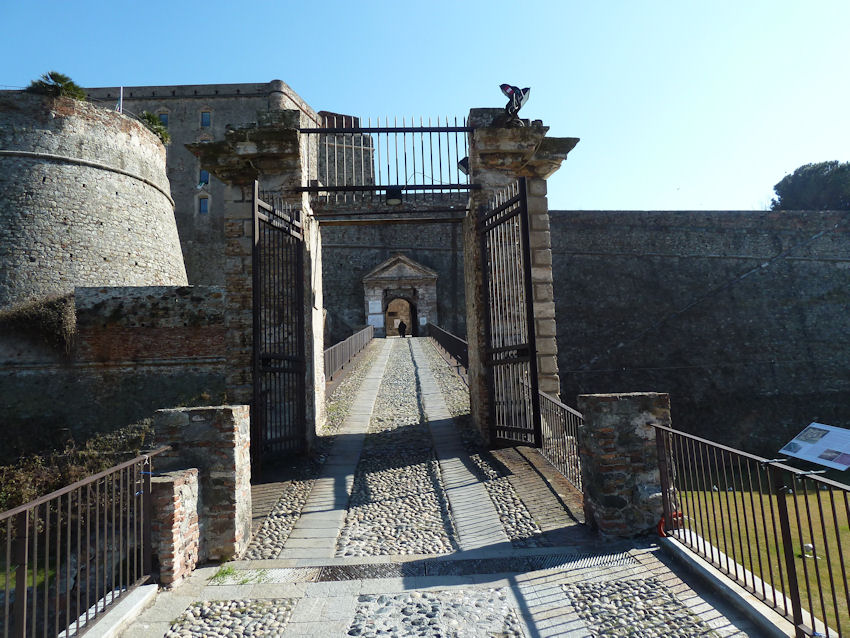
We're charging up the Bridge of San Giorgio to the castle gates.

The site was bronze age and later a pre-Roman Ligurian oppidum; the Lombards or Longobards destroyed it all in the 7th century, but the medieval city was founded on the Priamar promontory's summit, chiefly as a fortified religious citadel. Serious fortifications continued from the 1220s onward, but the lot of it was destroyed by the Genovese in 1528, and the main parts of the present fortress were built by the Genovese in the mid-16th century to keep the Saracens and the French at bay and the Savonese population paying their taxes promptly.
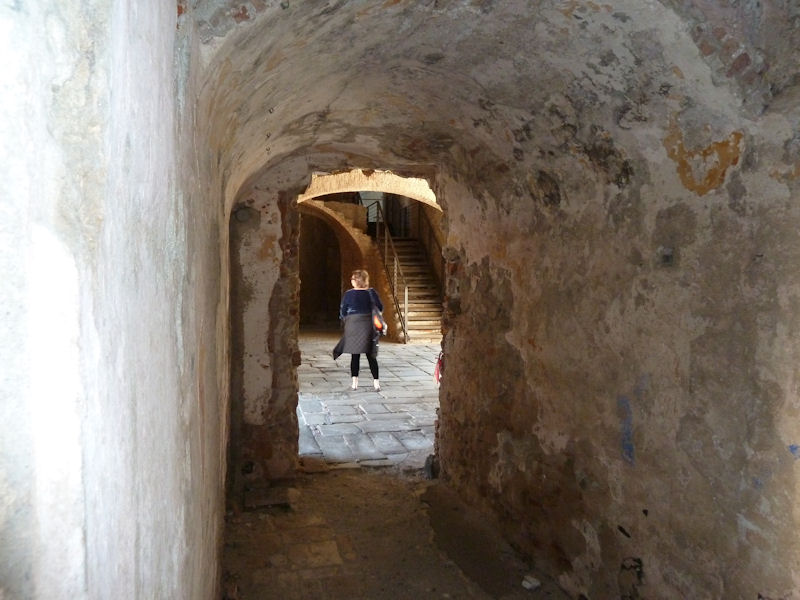
Kristin getting organized after our tour through the meagre but interesting archaeological museum in the Castello Nuovo building

Just offshore, the good ship Berden (built in 1982 for dry cargo, 80 metres long, no owner listed but flagged in Malta, as of today last seen here but now on its way to Diliskelesi, Turkey). (I spent a lot of time researching a 16th century spy sometimes called Nicholas Berden. No relation.)

This eccentric playground for kids, with rings of concentric moats, turns out to have been a gunpowder magazine built in the 1720s.

The southwestern outer walls over the present beachfront

The edge of the beach and jetty and some minor gun emplacements. The railroad line to the ferry port runs directly below us.
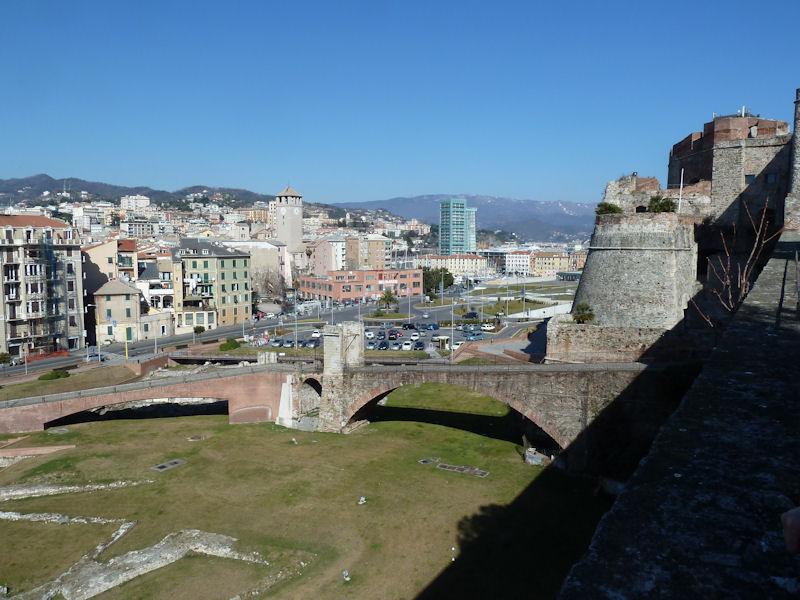
The Ponte San Giorgio

Excavations of former bastions of the fortress. On the right, under the San Giorgio bridge, are the excavated remains of a major Dominican religious establishment, where an important residential quarter was developing in medieval times under the protection of the fortress.

Downtown Savona and the mountains behind
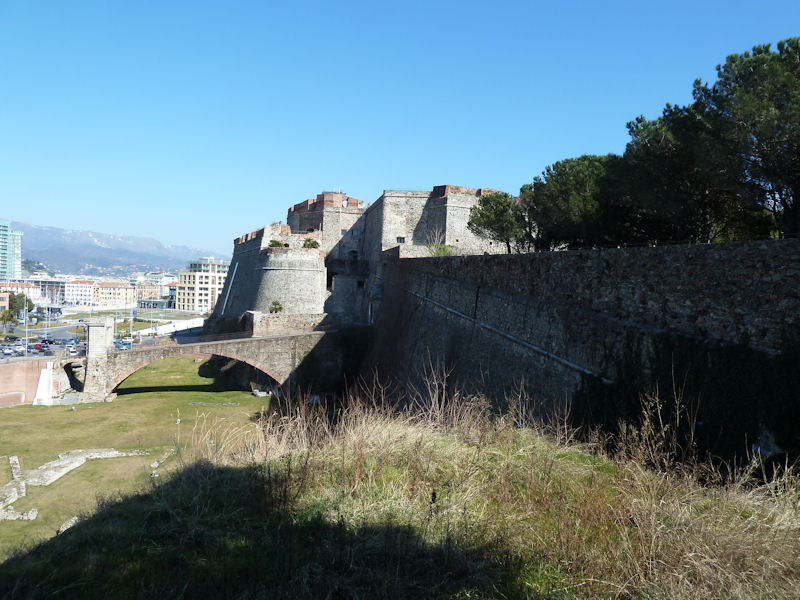
The Fortezza del Priamar from the farthest bastions, now civic park grounds

Kristin pausing between the fortress's "palaces" to watch the pigeons tucked into all the holes in the wall

Kristin testing all the castle defenses for a weak point

Up onto the walls around the Castello Nuovo
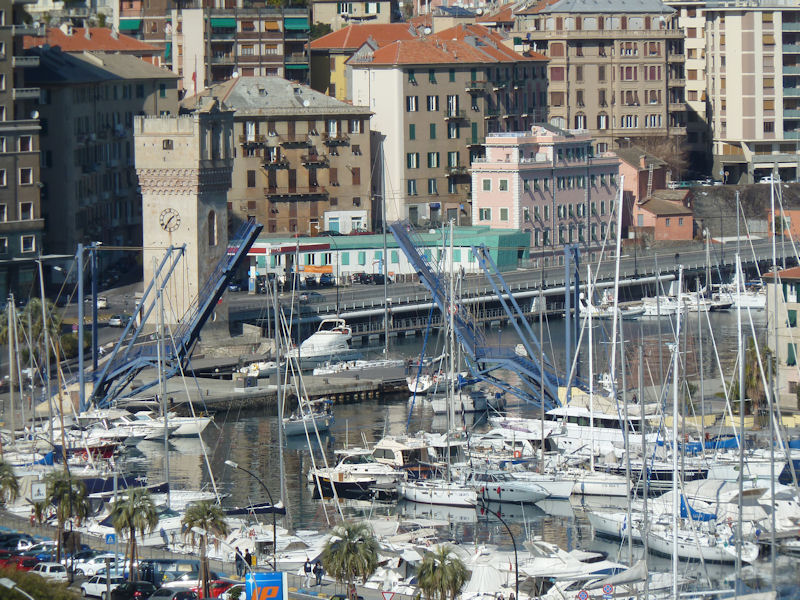
The drawbridge opened, as the rich guy's yacht glides through
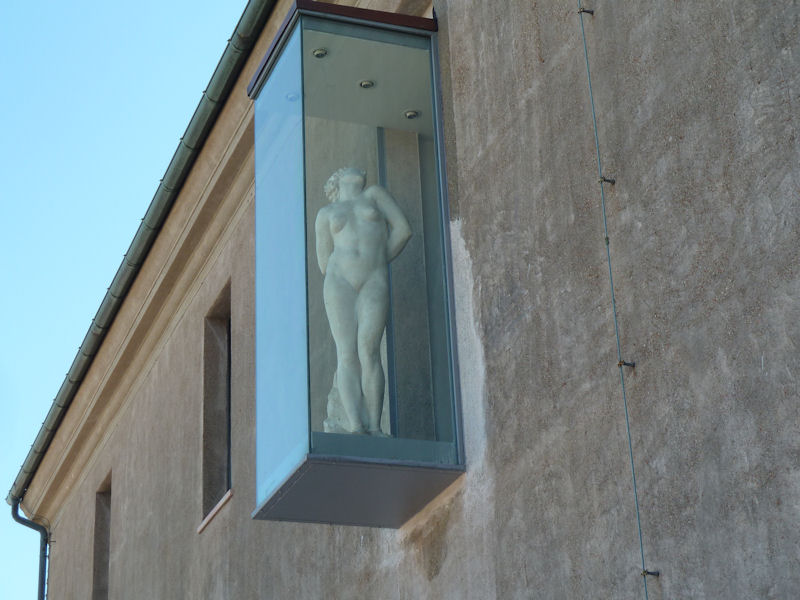
"Oh lady, put it away."

From the fortress, the ferry port out on the promontory

The Maschio piazza d'Armi or parade ground, with the Castello Nuovo on the left
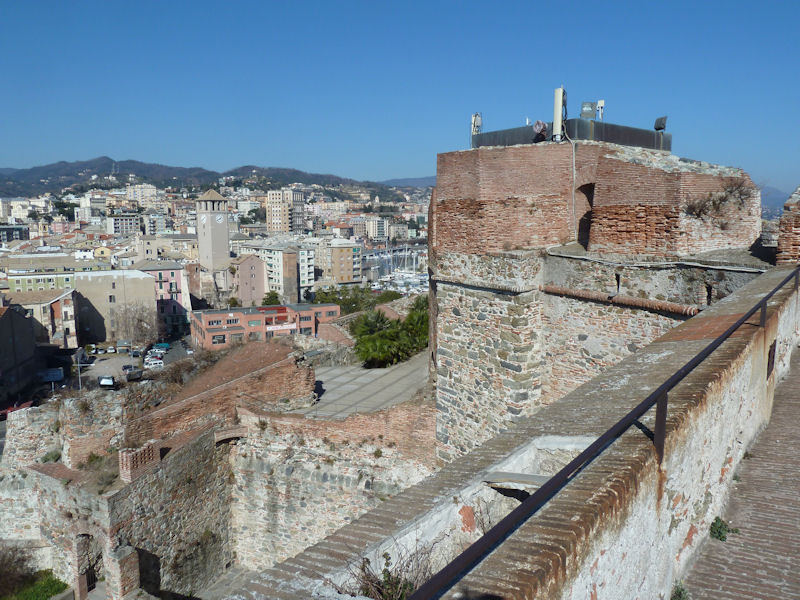
A view from the battlements out over the town. The Fortezza saw some serious unpleasantries in 1746 when the Genoese garrison surrendered to the Piedmontese, and considerable brawling during the battles between France and Austria in Napoleon's time. It fell into disrepair through the 19th century and was partially dismantled to make room for development and civic gardens, until excavations and restorations began in the 1950s.

The San Giorgio bridge and the Dominican complex to the right. The fortress, like all good fortresses, also served as a prison, of course, and this is just one more prison of many in which the Italian patriot Giuseppe Mazzini got locked up by the Savoyard monarchs.

Some of the outer bastions from the citadel

-- How do you work these things?

"Oh, lady, get back inside." A collection of the works of the sculptress Renata Cuneo is housed above the archaeological museum.
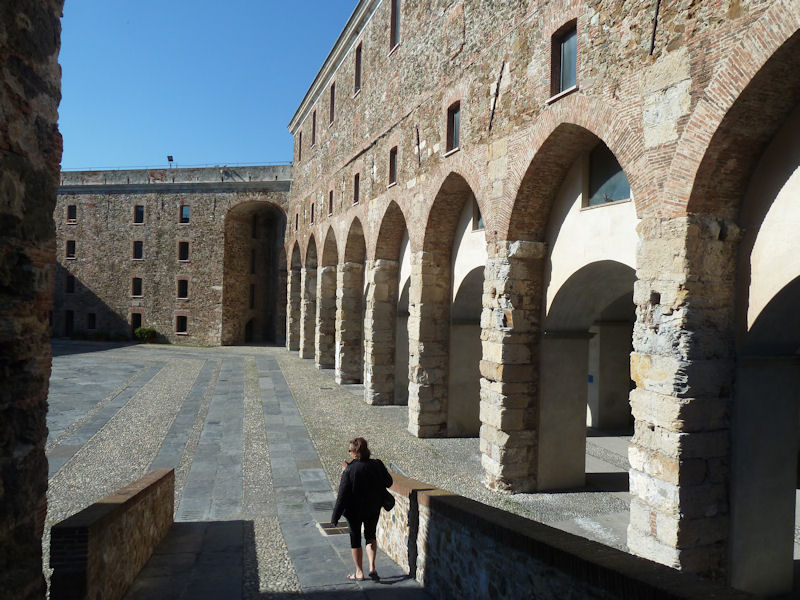
Back into the place d'armes and out the gate to the present century

The cathedral peeking out from down the street

Swearing off the television

The cathedral and belltower

The Cathedral of Santa Maria Assunta, dating from 1589-1605, with a façade from the 1880s.

On the far side is the Sistine Chapel (the "other" Sistine Chapel) from the 1480s, built by Pope Sixtus IV for his dear departed parents. (The churches are all closed up today; of course, it's Sunday.)

The Savona art museum, which we did not get to see.

Another nice church. Savona is not at all an insignificant place -- the Fortress is very worth a visit, and despite its long-time subjugation under the neighbors from Genoa, the city has not been without its historical impact. For example, if you look at Wikipedia's article on Savona you will find that this small city of only 62,000 citizens has already produced, not even counting the Discoverer of the Free World (C. Columbus), two popes, one Columbus wannabe, two TV hosts, one president and one prime minister of Italy, and seven national football players.

An interesting newish building rather hopefully called the Palace of Justice (as the Americans would say, that's "aspirational" and nonbinding).

We're crossing back towards the rail station over the mighty "Torrente Letimbro" in spate.

The Hall of Justice from the far side of the river, and so back to Genoa, suitably edified.

 Feedback
and suggestions are welcome if positive, resented if negative, Feedback
and suggestions are welcome if positive, resented if negative,  .
All rights reserved, all wrongs avenged. Posted 12 March 2012. .
All rights reserved, all wrongs avenged. Posted 12 March 2012.
|
 Dwight Peck's personal website
Dwight Peck's personal website

















































